January 2010
Monthly Archive
January 28, 2010
>WOW 360-degree views of Stonehenge – click here
Avebury and Stonehenge can be explored with the click of a mouse from today as the National Trust’s most famous sites have been added to Google’s Street View mapping.
Over 20 historic locations across the UK – including castles, landscapes and country houses – have been scanned using a panoramic camera, bolted to the back of a tricycle, and added to Google’s online mapping service.
Users can now take a 360-degree, ground-level tour of sites such as Corfe Castle in Dorset, Fountains Abbey in North Yorkshire, Lindisfarne Castle in Northumberland, and Plas Newydd in Wales.
Austen fans with a romantic sensibility can even take a virtual turn around Lyme Park in Cheshire – made famous by Colin Firth’s emergence from its lake as Mr Darcy in the BBC’s adaptation of Pride And Prejudice.
Google’s Street View cyclists pedalled over 125 miles on the 18-stone trike, following marked routes around the National Trust sites to capture them from every angle.
Ed Parsons, technologist at Google, said: “We were delighted to be able to open up some of the UK’s most famous landmarks to the rest of the world via the web.”
However, he does not believe the online experience will discourage tourists from visiting the sites in person.
“It’s a fun way to preview what to see and do on a day out,” he said.
“Or whet your appetite for where to go next.”
Google will continue to collect images from other National Trust sites throughout 2010, including UNESCO World Heritage Site the Giant’s Causeway, in County Antrim.
January 28, 2010
>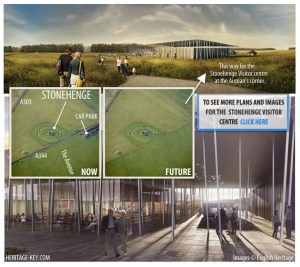
PLANS for the new £27.5million visitor centre and facilities at Stonehenge have been given the go ahead by Wiltshire Council.
Despite concerns raised about increased congestion, the size of the new car park and transportation from the centre to the ancient monument, 12 out of 13 councillors on the council’s strategic planning committee voted to approve the scheme.
The project involves building a new centre with a car park at Airman’s Corner, with a land train to take visitors to the stone circle.
The existing visitor centre and parking will be removed and the A344 from Stonehenge to the A303 will be closed off and grassed over.
Cars will be diverted to Longbarrow Roundabout and along the A360 to Airman’s Corner, where a new roundabout will be constructed.
“There is no question that something is needed,” said Amesbury councillor Fred Westmoreland. “To me, this site makes sense.
“Most of the objections which are being made are looking for a solution we are never going to get. This is the third planning application, or the fourth, and you will never get everyone to agree on everything.
“If in five years or five months time we find the road system does not work, no problem, we can change the system. If we find the buildings themselves are not working particularly well, we can amend them.
Cllr Christine Crisp said: “There is public money on the table to make this one happen. If it is delayed a year or two years, we will have no idea whether there is any public money on the table to make that development happen.”
Loraine Knowles, Stonehenge project director for English Heritage, said: “This is an important step in returning Stonehenge to a more dignified setting and creating facilities more fitting for a world-renowned tourist attraction.
“We can now begin to look forward to providing a much improved, high quality experience for visitors at an environmentally sensitive development.”
* Councillors also approved an application to move the Airman’s Cross monument from its current position at the staggered junction into the visitor centre grounds, where it will be placed next to the path from the car park to the centre.
English Heritage welcomes Stonehenge Vistor Centre decision
English Heritage has welcomed yesterday’s decision by Wiltshire Council’s planning committee to approve plans for a new visitor centre for Stonehenge.
Loraine Knowles, Stonehenge project director for English Heritage, said: “This is an important step in returning Stonehenge to a more dignified setting and creating facilities more fitting for a world-renowned tourist attraction.
“We can now begin to look forward to providing a much improved, high quality experience for visitors at an environmentally sensitive development.”
With planning permission in place for the visitor centre, plans for the closure of the A344 adjacent to the Stones (from the A303 to Byway 12) will now be put forward for approval. At the same time, Wiltshire Council will be consulting on proposals to restrict motorised vehicles on the remaining part of the A344 and on nearby Byways.
Following a lengthy consultation and extensive technical assessments, the Prime Minister announced on 13 May last year that Airman’s Corner would be the location for new Stonehenge visitor facilities. Together with proposals for the closure of the A344, the scheme will enhance the monument’s setting by removing the existing visitor facilities (including car parking) and improving the visitor experience with new exhibition and education facilities. A fully accessible transit system will run from the new visitor centre to a drop-off near the Stones.
Airman’s Corner is about 1.5 miles (2.5km) west from Stonehenge, on the junction of the A344 and A360. It is at the edge of the World Heritage Site and is easily accessible by road. The land is currently used for farming, with very few residents living close to the site.
January 27, 2010
>
Stonehenge may have been used as a site where knowledge was communicated ritually, according to a new theory.
Lynne Kelly, La Trobe University doctoral researcher and science writer, has been working on technologies oral cultures used to present and pass on scientific knowledge.
Kelly demonstrated the constant changes in the archaeology at Stonehenge are consistent with the mnemonic (conveying through chants and rituals) needs of the knowledge elite as they settle, while delivering the inaugural Marshall McLuhan Lecture in Chicago.
‘Instead of moving between sacred places to perform the cycle of ceremonies which encode all formal knowledge of their culture, Neolithic Britons replicated that landscape in the monuments they built over 1,500 years in transition from a mobile hunter-gathering to settled agriculture,’ says Kelly.
The Neolithic Britons who built Stonehenge, like other cultures starting to settle, lacked a written language with which to preserve their knowledge.
Kelly says the most reliable recording system they had were mnemonic methods, whereby knowledge ranging from animal behaviour to astronomy could be communicated.
To facilitate this, she argues that Stonehenge itself acted as a knowledge centre, a function that it had in common with many other sites around the world, says a university release.
Kelly’s research draws parallels with oral cultures such as Native American, African and Aboriginal Australian, and finds clues in the physical remains of Stonehenge.
January 21, 2010
>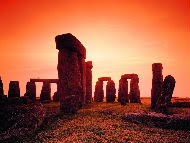
A new research project that promises to significantly improve our understanding of Stonehenge is going ahead after receiving an £800,000 grant.
Dr Oliver Craig, from the University of York’s Department of Archaeology, is part of the team behind Feeding Stonehenge, a follow-up to the earlier Stonehenge Riverside project which saw a wealth of material excavated from nearby Durrington Walls.
The latest stage of the research involves the analysis of that material, including pottery, stone tools and animal bones, to shed new light on the people who built and visited Stonehenge.
“Earlier investigations have made huge inroads into our understanding of what is one of the world’s most important prehistoric monuments but many questions remain unanswered”
Feeding Stonehenge is being supported by a grant from the Arts and Humanities Research Council.
Dr Craig said: “This research will allow us to gauge Stonehenge’s significance in the 3rd Millennium BC and the extent of its sphere of influence.
“Earlier investigations have made huge inroads into our understanding of what is one of the world’s most important prehistoric monuments but many questions remain unanswered.
“The next stage will focus on how the people who built Stonehenge lived, what they ate, when the monument was visited and where the visitors came from.”
Initial chemical analysis of cattle teeth found in the area suggests the animals were raised hundreds of miles away before being walked to Durrington Walls for slaughter and consumption.
One aim of Feeding Stonehenge that will be covered by the York team will be to try and understand what the pottery was used for by conducting chemical analysis of any organic residues present.
Pottery was used for domestic as well as ceremonial activities but it is not known what types of foods were prepared for these different activities.
The Feeding Stonehenge research is led by Professor Mike Parker Pearson of the University of Sheffield working alongside Dr Craig, Dr Umberto Albarella, from the University of Sheffield and Dr Jane Evans, from the NERC British Geological Survey.
January 18, 2010
Posted by StonehengeNews under
Uncategorized
Leave a Comment
>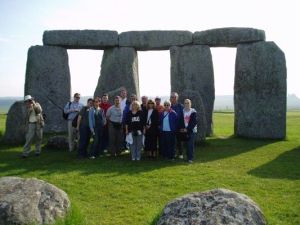
I am a professional tour guide who can provide ‘private’ guided sightseeing tours of Stonehenge for small groups.
I specialise in Stonehenge and ancient Britain and can often get permission from the English Heritage to take you beyond the fences and touch the Stones after the site is closed to the public. (special access or inner circle tours)
Private tours can depart from London, Salisbury, Bath or Bristol
Some of my popular ‘favourite’ day tour itineraries include:
King Arthur Day Tour
Stonehenge
Glastonbury and King Arthurs Avalon
Challice Well Gardens (reputed buriel site of the Holy Grail
Avebury Stone Circle
Silbury Hill
Great Heritage Trail Day Tour
Stonehenge
Roman City of Bath
Lacock Village
Castle Coombe
Wessex Explorer Day Tour
Salisbury Cathedral
Old Sarum Hillfort
Stonehenge
Avebury Stone Circle
Chalk Hill figures
Buriel Mounds
Crop Circles (April to Septemeber)
However, private bespoke tours can be tailored to suit your requirements and can offer the ultimate flexibility throughout your day (s) visiting almost any location you wish to visit.
I promise a well balanced day with continuous information about not only the places we visit but England in general. My style of touring guarantees an informative, entertaining day, certainly never boring.
I frequently see so called ‘professional’ guides giving an uninspired hasty tour of tourist attractions and then demand huge tips for their ‘sloppy’ services at the end of the day.
MY MISSION STATEMENT: In the unlikely event of you not being entirely satisfied with my services I will NOT charge you!
I truly appreciate that many of you will only visit Stonehenge or England once and deserve a great experience.
I can supply 100’s of testimonials from satisfied customers (individuals/ families/groups) and have a 1st class reputation with many of the UK tour operators. (my heads getting bigger and bigger the more I write) Seriously folks, give me the opportunity to quote for your private group tour (1 – 16 passangers) and I wont disappoint.
By contacting me direct you can also ‘cut out the middle man’ i.e travel agents who add a big fat commission for doing little
Direct Email: tour.guide@rocketmail.com
January 15, 2010
>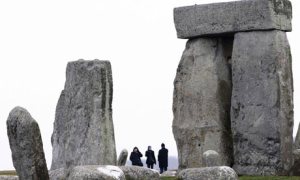
Britain’s failure to deal with road traffic around the prehistoric stone circle is condemned as ‘a national disgrace’
The traffic-choked roads still roaring past Stonehenge in Wiltshire have earned the world’s most famous prehistoric monument a place on a list of the world’s most threatened sites.
The government’s decision to abandon, on cost grounds, a plan to bury roads around Stonehenge in a tunnel underground and the consequent collapse of the plans for a new visitor centre, have put the site on the Threatened Wonders list of Wanderlust magazine, along with the 4×4-scarred Wadi Rum in Jordan, and the tourist-eroded paths and steps of the great Inca site at Machu Picchu in Peru.
Lyn Hughes, editor in chief of Wanderlust, said the A303 and A344 junctions near Stonehenge meant the site was “brutally divorced from its context”. She said: “Seeing it without its surrounding landscape is to experience only a fraction of this historical wonder. The fact that the government and various planning bodies cannot agree on implementing a radical solution to this problem is a national disgrace.”
The first great earth banks and ditches of the monument date back 5,000 years, and it was then repeatedly remodelled, with the addition of the circle of sarsen stones the size of doubledecker buses, and smaller bluestones brought from west Wales, and said to have healing powers.
Hughes was echoing the words 21 years ago of the parliamentary public accounts committee, which in 1989 damned the presentation of the site and the facilities for tourists as “a national disgrace”.
Since then millions have been spent on alternative road plans and architectural designs for the visitor centre, on exhibitions, consultations and public inquiries, without a sod of earth being turned.
Argument about how to care for the site raged throughout the 20th century: the circle itself is in the guardianship of English Heritage, while the National Trust owns thousands of acres of surrounding countryside, studded with hundreds more henges, barrows and other prehistoric monuments.
At the moment the best hope is that a much simpler and cheaper visitor centre can still be created, two kilometres from the site, in time for London’s hosting of the 2012 Olympics.
January 14, 2010
>
The team who worked on the Stonehenge Riverside Project in 2009 are to return to their findings to explain the eating habits of the people who built and worshipped at the stone circle over four thousand years ago. Once again led by Professor Mike Parker Pearson from the University of Sheffield, the new ‘Feeding Stonehenge’ project will analyse a range of materials including cattle bones and plant residue.
At the time of the Winter Solstice experts believe people would have brought livestock with them to Stonehenge for a solstice feast. Initial research suggests the animals were brought considerable distances to the ceremonial site at this time of year. “One of the unforeseen outcomes (of the Stonehenge Riverside Project) is the vast quantity of new material – flint tools, animal bones, pottery, plant remains, survey data, and chemical samples – which now needs analysing,” explained Professor Parker Pearson. “We are going to know so much about the lives of the people who built Stonehenge – how they lived, what they ate, where they came from.”
A large collection of cattle jaws collected during the last few years’ excavations will now undergo strontium and sulphur isotope analysis to establish where they originally came from and when they were culled. This will give experts a better idea of where people had travelled from to visit the site. The research will also offer a better understanding of the dressing of the famous sarsen stones of Stonehenge and insights into how the public and private spaces at Durrington Walls and Stonehenge differ from each other. Researchers will also try and ascertain whether Britain’s Copper Age started 50 years earlier than first thought. Circumstantial evidence points to copper tools being in use at Durrington Walls earlier than originally thought. Cut-marks on animal bones should reveal whether they were made by copper daggers as opposed to flint tools.
“I’ve always thought when we admire monuments like Stonehenge, not enough attention has been given to who made the sandwiches and the cups of tea for the builders,” said Parker Pearson. “The logistics of the operation were extraordinary. Not just food for hundreds of people but antler picks, hide ropes, all the infrastructure needed to supply the materials and supplies needed. Where did they get all this food from? This is what we hope to discover.”
‘Feeding Stonehenge’, will take place over the next three years. Find out more about the Stonehenge Riverside Project at: http://www.shef.ac.uk/archaeology/research/Stonehenge
January 12, 2010
>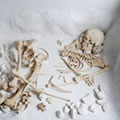
THE new Stonehenge visitor centre will show off artefacts from Salisbury and South Wiltshire Museum’s collection to a wider audience English Heritage is collaborating with the museum and Wiltshire Heritage Museum to present and interpret the story of the World Heritage Site in a dedicated exhibition space in the centre, at Airman’s Corner.
In returning for loaning items from their collections, the museums will get help from English Heritage with their own displays and with enhancing their archives.
Loraine Knowles, Stonehenge project director at English Heritage, said: “The exhibition will be part of an overall experience that will draw on all the senses and lead people to a greater understanding, not just of Stonehenge, but of the people who built it.”
Salisbury museum director Adrian Green said: “We look forward to supporting the development of the visitor centre, and also redisplaying our own nationally important collections from the World Heritage Site to complement the new exhibition at Stonehenge.”
David Dawson, director of the Wiltshire Heritage Museum, said “Together we can present the full story of Stonehenge and encourage visitors to explore Wiltshire.”
January 11, 2010
>
I just had to add this web link. This very funny sketch by the comedian Eddie Izzard about Stonehenge is sure to put a smile on your face.
Click on this link and enjoy!
Oh Yeah – What exactly is a Pagan ?
A brief introduction
Paganism is a spiritual way of life which has its roots in the ancient nature religions of the world. It is principally rooted in the old religions of Europe, though some adherents also find great worth in the indigenous beliefs of other countries. Such belief in the sacredness of all things can be found world-wide. Pagans see this as their heritage, and retain the beliefs and values of their ancestors in forms adapted to suit modern life. We celebrate the sanctity of Nature, revering the Divine in all things; the vast, unknowable spirit that runs through the universe, both seen and unseen.
Pagans honour the Divine in all its aspects, whether male or female, as parts of the sacred whole. Every man and woman is, to a Pagan, a beautiful and unique being. Children are loved and honoured and there is a strong sense of community. The woods and open spaces of the land, home to wild animals and birds, are cherished. Paganism stresses personal spiritual experience, and Pagans often find that experience through their relationship with the natural world that they love. We seek spiritual union with Divinity by attuning with the tides of Nature and by exploring our inner selves, seeing each reflected in the other. We believe that we should meet the Divine face to face, within our own experience, rather than through an intermediary. Although some paths do have leaders and teachers, these people act as facilitators, using their own wisdom and experience to help guide those in their care towards discovering their own sense and interpretation of the Divine. Our rites help us harmonise with the natural cycles, and so they are often held at the turning points of the seasons, at the phases of the moon and sun, and at times of transition in our lives.
There is a great variety of traditions within the broad spectrum of Paganism. This reflects the range of our spiritual experience, for we believe that everyone is unique, and so everyone’s spirituality must be equally unique. Some Pagans follow multiple Gods and Goddesses, their names familiar to all from the pages of European folklore and mythology: others focus on a single Life Force of no specific gender; yet others devote themselves to a cosmic couple – Goddess and God, or Lord and Lady. We celebrate our diversity for we believe that each person should find their spirituality according to the dictates of the quiet, inner voice of their own soul. For this reason we respect all sincere religions, and do not proselytise or seek converts. From other faiths and from society generally, we ask only tolerance.
In these days of environmental concern and eco-awareness, Pagans are often at the forefront of Green awareness. Pagans of all paths respect the rights of every living soul, whether human, animal, plant or rock. We are ever mindful of the actions of cause and effect, whether by thought or deed, upon the creatures of the Earth. We encourage free thought, creative imagination and practical human resourcefulness, believing these to be fundamental to our spending our lives in harmony with the rhythms of the natural world. We rejoice that some of our personal beliefs should now be shared by so many other people. These beliefs are the heritage of all people from our distant and common ancestors – they are equally the concern of all our descendants.
January 8, 2010
Posted by StonehengeNews under
Uncategorized
Leave a Comment
>
Many of you have been eagerly awaiting the release of Stonehenge ‘special access’ tours for 2010
I have been contacted by some of the London Tour operators who have just published their dates for March – September this year.
I can highly recommend the following tour operators;
The Sightseeing Tour Company
www.BestValueTours.co.uk
OR
Gr8xpectations (AllstarLeisure Ltd)
www.Welcome2Britain.com
These companies have been operating tours for over a decade and I have recieved excellent feedback about their tours and customer service.
It is important to book these tours early as they are extremely popular!
There will be some more dates published soon with different itineraries – watch this space………….. I hope this has helped – good luck !
Their itinerary is as follows:
STONEHENGE INNER CIRCLE TOURS:
Highlights: Private viewing of Stonehenge at sunset * Enter the stone circle and touch the stones * Visit Lacock, a delightful Saxon village * See where Harry Potter and Pride and Prejudice were filmed * Meal stop in a 13th century inn (food/drinks not included) * Visit Bath – free time to shop and explore * Entrance to the Roman Baths and Pump Room included
After your pick-up directly from or near to your hotel, we drive to Bath to visit the Roman Baths and Pump Room. In the late afternoon we visit Lacock for an early evening supper in a 13th century inn, before driving to Stonehenge. As the sun begins to set, we enter the stone circle (which is normally roped off to the public) for a unique private viewing. The most dramatic and atmospheric way of visiting Stonehenge.
Stonehenge – Private Viewing at Sunset and tourch the Stones
Built nearly 5,000 years ago, Stonehenge is the most popular prehistoric monument in the world. Most visitors to the site are not allowed direct access to the stones. With Premium Tours you get that access, with a private viewing of the mysterious monoliths. We will enter the stone circle itself and stand beside the mighty Sarsen rocks towering above us. Our guide will explain the history of this ancient site, pointing out the altar, slaughter and heel stones, above which the sun rises dramatically on the summer solstice. There will be time to enjoy the peace, away from the crowds, as we experience Stonehenge at its most mystical and atmospheric best. Not to be missed!
Lacock
Lacock is a little known, picturesque village dating back to the Saxon era. Many of the beautiful buildings originally formed part of an extensive monastic complex and are now owned by The National Trust. So pretty is the village that it has provided the setting for many movies and television dramas including Jane Austens Pride and Prejudice and more recently Harry Potter and the Philosophers Stone. We will take a delightful walk before we enjoy an early evening supper* (or breakfast for morning tours*) in The George, a vintage English pub built in 1361.
*food/drink not included
Bath
Bath, a world heritage site, is a beautiful Georgian city with delightful crescents, terraces and architecture. There will be plenty of time to visit Bath Abbey, or to shop and explore. Your guide will also conduct an optional walking tour to show you where Charles Dickens lived and worked as a young man, and a give you a chance to sample some delicious cheeses fresh from the local dairy farms. Then we will enter the magnificent Roman Baths, where over one million litres of boiling water still burst free from the hot springs everyday.
We are please to offer this tour on the following dates:
2010 OPERATING DATES
Month Date
January 2010 2nd, 15th, 25th
February 2010 1st, 5th, 8th, 15th, 22nd, 26th
March 2010 1st 4th, 8th, 11th, 15th, 26th
April 2010 1st, 4th,7th, 8th, 11th, 12th, 15th, 17th, 18th, 21st, 22nd, 25th, 26th, 29th
May 2010 5th, 6th, 9th, 10th, 13th, 16th, 19th, 23rd, 24th, 27th, 30th
June 2010 3rd, 6th, 7th, 10th, 13th, 16th
July 2010 1st, 4th, 7th, 8th, 11th, 12th, 15th, 18th, 22nd, 25th, 26th, 29th
August 2010 5th, 9th, 12th, 15th, 18th, 19th, 23rd, 26th, 29th
September 2010 2nd, 5th, 6th, 9th, 12th, 16th, 19th, 30th
Next Page »











